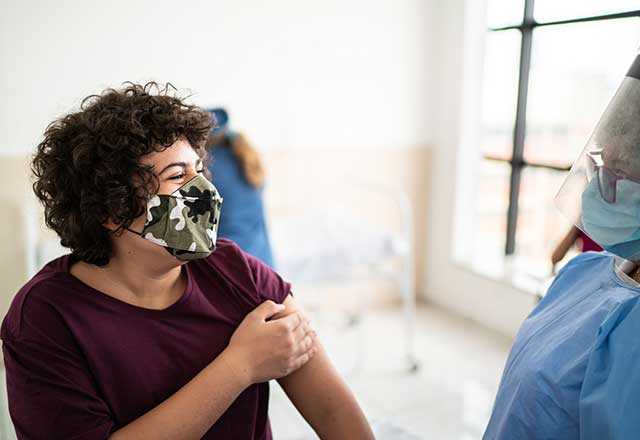Making COVID-19 Vaccine Shots Easier on Children

M-Irfan Suleman, M.D., director of pediatric chronic pain interventional management at Johns Hopkins Children’s Center and medical director of the multidisciplinary pediatric pain rehabilitation clinic at the Kennedy Krieger Institute, suggests ways to ease stress for children during COVID-19 vaccinations.
Every effort should be made to ensure that the vaccination procedure is not traumatic for the child, to prevent instilling a fear of pain. If the first shot goes smoothly, with minimal pain, the second shot will be easier. Children with chronic pain need special attention to prevent amplification of that pain.
Getting a COVID-19 vaccination can help protect a child from developing COVID-19 or from becoming seriously ill with the disease. Current information shows that the vaccines may also help stop people from spreading the coronavirus that causes COVID-19 to others. Help protect your entire family by getting yourself and your children age 12 and older vaccinated against COVID-19.
Get a COVID-19 vaccine for your child as soon as you can.
- The vaccines are safe and effective.
- Only the Pfizer-BioNTech COVID-19 vaccine is currently approved for children age 12 and over.
- A second shot of the Pfizer-BioNTech COVID-19 vaccine is necessary three weeks after the first shot.
Vaccination Tips for Caregivers and Health Care Providers
- Use an ointment or cooling spray. Apply over-the-counter pain-relieving lidocaine 4% ointment or a lidocaine patch at the site of the injection 30 minutes before vaccination, or use a cooling spray (vapocoolant) just before the shot.
- Be honest and calm. Explain that the child may feel a little pinch, but that it will go away very fast. Use words like “pressure” or “poke” rather than “pain” or “shot.” Support the child if he or she cries.
- Find a comfortable position. The child should sit in a caregiver’s lap or lay down during the vaccination, and can continue for comfort during the 15 minute observation period.
- Let the child hold a favorite item. Bring anything that is comforting, like an iPad or a favorite toy, stuffed animal, blanket or book, to help the child focus on something pleasant.
- A 25-gauge or 30-gauge needle may be used to minimize pain during the vaccination.
- Distract the child. Right before the shot, play with an iPad, sing the child’s favorite song, tell a story or just act plain silly to pull the child’s attention away from the shot. Keep the distraction going after the vaccine is given.
- If the child is older, ask him or her to take deep breaths to help “blow out” the pain, imagining that the pain is leaving their mouth.
- Provide care after the shot. Calm the child with hugs, cuddles and soft whispers.

